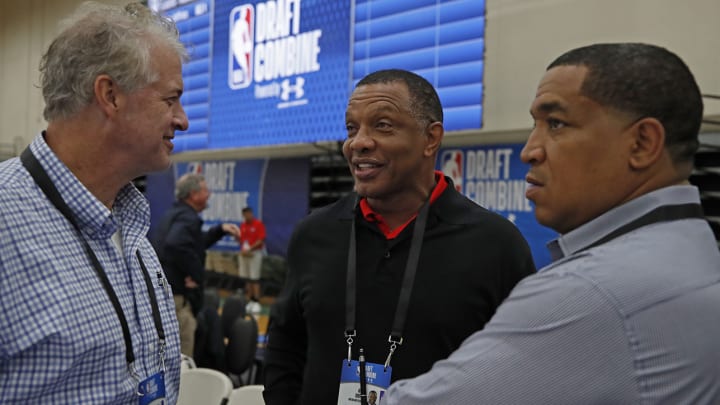An Inside Look at the NBA's Annual Mixer: The Draft Combine

CHICAGO – I love the draft combine.
It’s like an NBA mixer. It’s the two-week Las Vegas Summer League condensed down to a few days, with NBA executives crammed into a small venue instead of spread out in two big gyms. It’s a chance to get face time with anyone you need to talk to. It’s in a great city at a great time of year.
For me, there is value in attending the combine.
For NBA executives … I wonder.
On paper, the combine offers a lot. Scores of players, from the elite (Duke phenom Zion Williamson) to the intriguing (UCF’s Tacko Fall), all in one gym, available for testing, medical workups, interviews and five-on-five play.
Except not everyone goes through the athletic testing process. Williamson popped into Chicago for the draft lottery, did a couple of interviews with the Pelicans and Grizzlies—the two teams holding the top-two picks—and jetted out of town. Ja Morant and R.J. Barrett, the likely next two picks after Zion, stuck around for the combine but also declined to go through the testing process.
Far fewer actually play. It would be pretty cool to see Zion share the floor with Barrett and Cam Reddish again. Or see the handful of Kentucky guys go up against each other. But the five-on-five portion of the combine has become the battle of the second-round prospects. It’s Darius Bazely against Ky Bowman, Luka Samanic vs. Kyle Guy.
“It’s great for our G-League scouts,” said one high-ranking team executive. “For us, it’s a waste of time.”
The five-on-five’s shouldn’t be needed in the evaluation process. One executive recalled a line Donnie Walsh once told him: If you are starting your work on a guy in Chicago, you aren’t doing your work. Besides, the interviews have value. “It’s a first job interview for these kids,” an NBA personnel scout told SI.com. “Most of the time you have already done a lot of background on these players. You get into the room, you can bring up specific things. If there is something negative you heard, you can ask a question regarding that, without letting on who told you. It can be a hypothetical, like ‘How would you handle this situation.’ You ask a kid to tell us a little about yourself, to see what's the first thing that they mention.”
The combine itself is staffed with various team personnel, which offers executives another chance to peel back the curtain. Players are often prepped for team interviews and the 15-minute media gaggles are utterly useless. But teams that do have employees working the combine, from coaches to training and medical staff, will often ask how a player acts when the cameras are not rolling. How they interact with people? Who they interact with? What they are willing to do and what they won’t?
Said one executive, “It’s all about information.”
For many top executives, the value of being at the combine has nothing to do with the combine. It’s breakfast meetings with player agents, where the broad strokes of free agency are discussed, where they can alert agents (tampering alert!) about clients they might be interested in. It’s interpersonal interactions with other executives, where the seeds of trades can be planted.
The combine itself isn’t going to get better. There’s little upside for the top prospects to play in five-on-five, not with at least 30-plus games of tape already available on them and the possibility that they could play poorly. That’s not changing. And most teams don’t care. They do care about the guys who skip the medicals, some because they have a promise from a team to select them with a certain pick, a practice that has become increasingly popular, several executives tell SI.com.
“What I would change is that a player has to do medicals or he can’t be drafted,” said a veteran GM. “I’d like the [athletic] testing results, too, but the biggest thing is the medicals.”
The combine is the official launch of the draft process, with agent workouts, individual workouts and hundreds of hours of tape-watching to come. It’s not a perfect event, but next year everyone will be back (there have been preliminary discussions about moving the combine to Boston, a league source told SI.com, to the Auerbach Center, the Celtics sparkling new practice facility, though the central location of Chicago could keep the event there) ready to do it all over again. The NBA’s annual mixer will go on.

Chris Mannix is a senior writer at Sports Illustrated covering the NBA and boxing beats. He joined the SI staff in 2003 following his graduation from Boston College. Mannix is the host of SI's "Open Floor" podcast and serves as a ringside analyst and reporter for DAZN Boxing. He is also a frequent contributor to NBC Sports Boston as an NBA analyst. A nominee for National Sportswriter of the Year in 2022, Mannix has won writing awards from the Boxing Writers Association of America and the Pro Basketball Writers Association, and is a longtime member of both organizations.
Follow sichrismannix